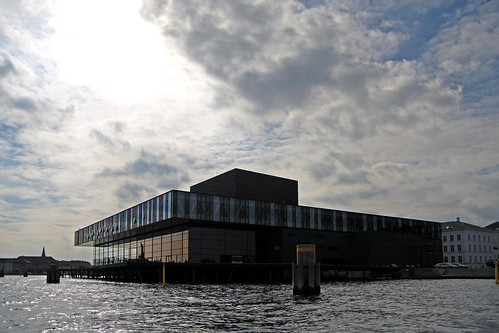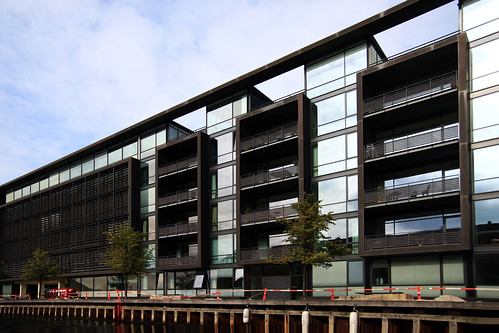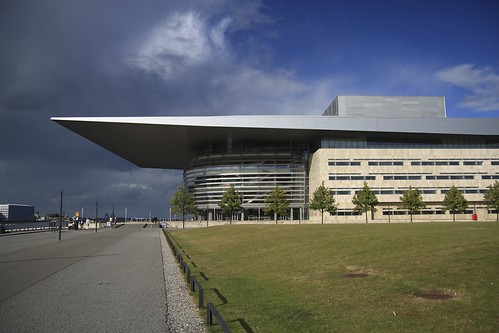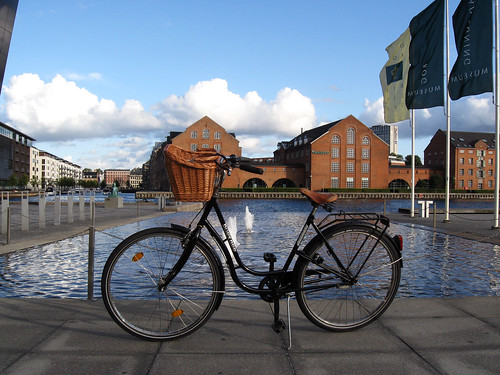
Sep '09 - Dec '11
Hello from Copenhagen!
I thought I would split my first post into two sections to give an idea of what things are like both inside and outside of school.
1. The City and Culture
Copenhagen is a small, dense, exhilarating, EXPENSIVE place to be. (When I say small, I don't mean that it's a grassy outpost in Outer Kookamunga but more that it is condensed city, which I think is a good thing.)
I remember once someone telling me that there was nothing to Copenhagen but rows and rows of apartment blocks, making it sound a rather drab and boring place to be. I'm happy to report that this is not the case! While there are lots of apartment blocks (some of which, as can be expected, are rather ugly), the city is a pleasant mixture of old and new, and it seems like it's finding a new life for itself through its status as a 'green' city. The harbor is undergoing a transformation--as most waterfronts are right now--from industrial corridor to cultural hotspot, leading to some interesting architecture:
Copenhagen Playhouse, Lundgaard & Tranberg Arkitektfirma
Offices, Henning Larsen
Copenhagen Opera House, Henning Larsen
(The school is actually located just behind the opera house, on the island of Christianshavn, in a complex of buildings that used to be for military use.)
I was under a slight delusion when I heard that Copenhagen was the 7th most expensive place to live on earth. I had convinced myself that while rent might be high, other things essential to daily life would still be normal. Globalization, right? And it's part of the EU, how could it be THAT much more expensive than other European countries? Well. In case you're under the same delusion...
After a month of living here, I've come to the conclusion that most of the 'different' grocery stores are actually owned by one of the two leading monopolies here, and they just switch around their 'deals' every so often to make it seem like there's competition. It goes much further than groceries, however. Besides the VAT ('Value Added Tax') of 20% on everything, it seems to me that the base price of goods and services are just.... higher.
I guess that's the price you pay for living in such a socialized country--there's no motivation for competition since there is a pretty equalized standard of living, and it seems like everyone can afford all the same things. But they pay so much for the simplest things! I have been trying to find a mop in the last month that is under $40 CAD. I went into a store yesterday and asked how much a simple mop with a squeezable head cost. The owner told me '400 Crowns.' That's 80 bucks! Since when would anyone ever pay $80 for a mop??
I can say, though, that the cost of living is somewhat offset by the fact that I can bike anywhere in the city within 25 minutes, and I can easily take the train all over the place for relatively cheap. So, if living is high, at least travel is cheap(ish). AND, there seem to be lots of occasions for free food and booze within the city if you can co-ordinate your dinner with the openings for art shows, dance shows, or other exhibitions.
And... biking in Copenhagen is awesome.
2. The Academy
Coming from a Canadian University, I had no idea what to expect in terms of curriculum, administration, and how the semester is structured here. And while some things are strangely absent (student cards, a schedule, online registration, or any sort of registration for that matter), most things feel very professional, if that makes any sense.
For example, the school of architecture is divided into departments on a scale from Urban Design to Product Design and everything in between, including experimental structures, hybrid architecture, etc. For the English master's program, there were only 2 departments that you could apply for: Department 2 or 11. My boyfriend, also from Canada, got into Department 2, and I'm in Department 11. Each department has their own office, teaching spaces, and studios.
My department, Design in an Architectural Context, is sort of hard to pin down. It's not exactly product design, as our first project is a bridge, but it's definitely not based on designing buildings. I'd say it's more about how design underlies everything, from the XL (bridge) to the XS (lamp or chair), and about understanding the human scale in relation to these large and small things.
So far the month of September has been dedicated to week-long workshops that are related to but not directly involved with our actual project. The first few days we worked with our instructors on something called 'feel the forces', where we built a span with wooden dowels and string, and a tower with pipecleaners and straws. They wanted us to understand the potential forces that would be acting on our bridges so that we could incorporate optimized structure into our designs.
The span requirements: a span of 90cm, as light as possible, which can support a brick for 15 seconds.
The tower requirements: a tower as tall as the ceiling, built from only straws and pipecleaners that can support a glass of water from the top.
Week 2 was about mapping of the site. It turned out that the site we were assigned wasn't the real site for the bridge, which was a bit confusing. But in the end, it was a good exercise to get us back into site analysis and how to convey your sense of the site to other people.
Week 3 was about structure, morphology, and pattern. Instructor Olga Popovic and Thomas Mikkelsen gave lectures about structure from nature and what sort of forces they take, and how they distort or respond to forces. Between lectures, we had to make a series of models, which ultimately we whittled down to a selection of 3 to be built at a larger scale and installed in the department lobby.
Our group decided on a bird's nest:

Finally, week 4 was an introduction to Rhino, where we did tutorials and started to understand how to manipulate curved surfaces to our whims. In the end we each did a small laser-cut model, which was still cutting at 4pm on Friday.
This week we will be introduced to our semester project, which we know is a bridge (but where?). My understanding is that our final work is to be displayed at a design fair in Stockholm in February, which would be very exciting indeed!
2 Comments
Great post Stephanie!
I've always wondered why Copenhagen, although relatively expensive across the board(coming from the US/Japan), had EXTREMELY EXPENSIVE food. Thanks for clearing it up for me, I was starting to think it was government initiative to skinny-up the population.
Nice pictures.
to further unravel the mystery of "expensive" life in Scandinavia:
http://www.thedailyshow.com/watch/tue-april-21-2009/the-stockholm-syndrome-pt--1
http://www.thedailyshow.com/watch/wed-april-22-2009/the-stockholm-syndrome-pt--2
Block this user
Are you sure you want to block this user and hide all related comments throughout the site?
Archinect
This is your first comment on Archinect. Your comment will be visible once approved.